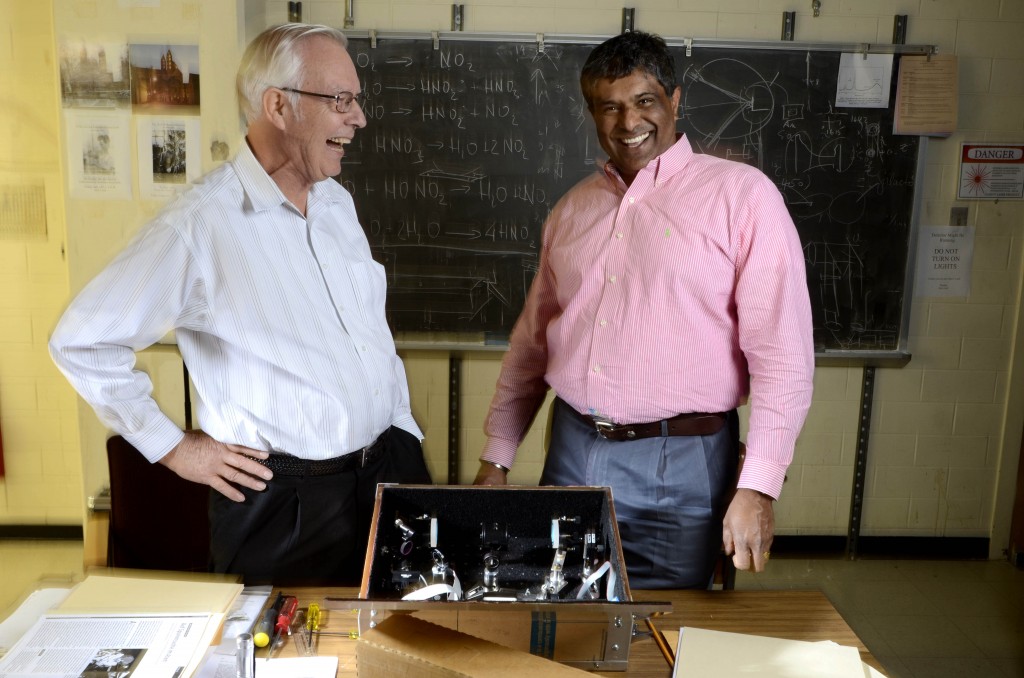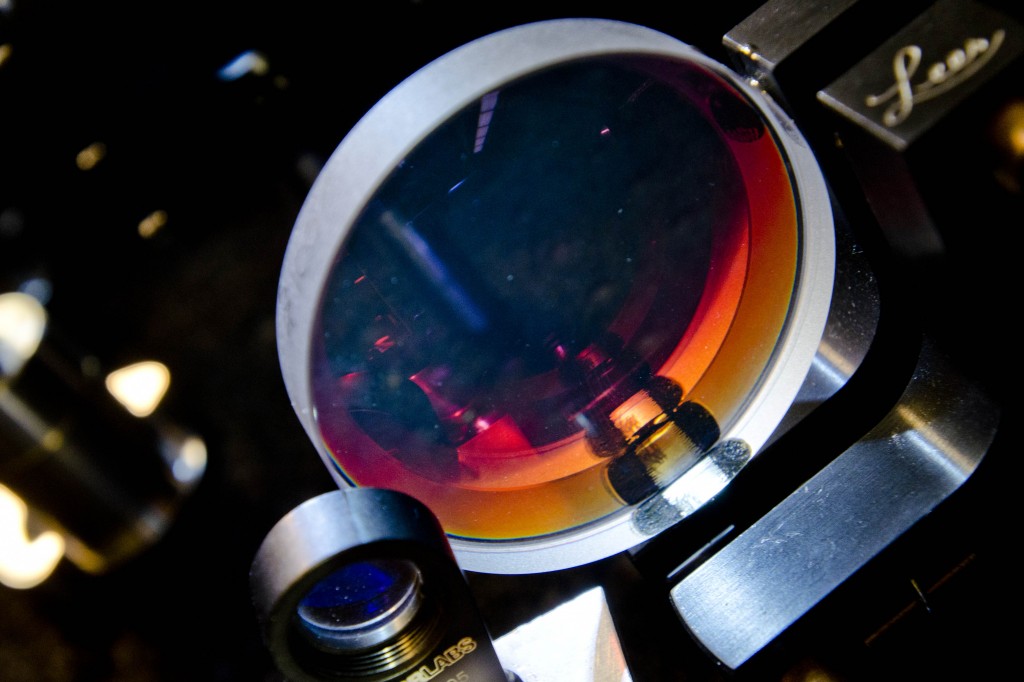Physicist Manfred Fink has built a stripped down Raman Spectrometer that can cheaply test for earthquakes, lung cancer and lactose intolerance.
 Professors Fink (left) and Varghese (right) happy with the “little black box” that holds all the optical components for Raman measurements in the breathalyzer application. Marsha Miller photo.Manfred Fink didn’t set out to build a device that could cheaply test for earthquakes, lung cancer and lactose intolerance. Fink, a professor of physics in the College of Natural Sciences, set out to do the kind of thing that an experimental physicist might do — try to pin down the rest mass of the electron neutrino.
Professors Fink (left) and Varghese (right) happy with the “little black box” that holds all the optical components for Raman measurements in the breathalyzer application. Marsha Miller photo.Manfred Fink didn’t set out to build a device that could cheaply test for earthquakes, lung cancer and lactose intolerance. Fink, a professor of physics in the College of Natural Sciences, set out to do the kind of thing that an experimental physicist might do — try to pin down the rest mass of the electron neutrino.
After many years and many millions of dollars, Fink and his collaborators were forced to acknowledge that they’d failed to determine the rest mass of the neutrino (which remains only approximately known to this day). They also had to acknowledge that their funding had dried up.
It was a serendipitous failure, however — the kind one often finds at the point where basic science makes the leap to applied technology.
In the course of his neutrino hunt Fink had further refined a Raman Spectrometer that he’d been developing for a number of years with Aerospace Engineering Professor Philip Varghese.
Fink and Varghese had first designed their spectrometer, a laser-based tool commonly used to measure the chemical composition of different substances, to analyze pollutants in stack gases. For the neutrino project Fink stripped it down even further to look for impurities in tritium gas, a radioactive isotope of hydrogen that can generate neutrinos, which are electrically neutral subatomic particles.
“By that time we had less funding and we became more and more consciously driven by — let’s make it simple,” remembers Fink. “We didn’t want to measure the whole world. We just wanted to measure our lousy little tritium to see if it was clean.”
As the original project neared its end, Fink realized that this device he’d made wasn’t just good for analyzing tritium gas or stack gases. You could tune it to analyze the chemical composition of pretty much any gas in a variety of mediums. You could do it really cheaply. And the device was small enough to wheel around like a piece of carry-on luggage.
He and Varghese realized there might be a market for such a thing.
“Measurement science has gone through a series of revolutions,” says Varghese, chair of Aerospace Engineering and Engineering Mechanics in the Cockrell School of Engineering. “I think the latest revolution is the combination of optics and electronics, and solid state electronics and solid state lasers. It’s enabling a whole new class of measurements that we couldn’t do easily in the past.”
Thus was born the Analytic Non-Dispersive Raman Spectrometer — ANDRaS for short.
“This is a perfect example of why we do basic research and should always seek enterprise opportunities from science,” says Skip Porter, associate dean for innovation and science enterprise. “Think about this. Looking for the rest mass of an electron neutrino leads to the development of an instrument that has so many important uses.”
 Close-up view of the lens used to focus the laser beam into the multi-pass cell, adjacent to entrance mirror seen from behind. Marsha Miller photo.
Close-up view of the lens used to focus the laser beam into the multi-pass cell, adjacent to entrance mirror seen from behind. Marsha Miller photo.
It uses a tiny infrared laser diode similar to ones used in portable CD players. The laser shoots through a water or gas sample, its photons colliding with various molecules in the sample. Most of the photons emerge from these collisions basically unchanged. They have the same energy and wavelength they had when they went in.
A few of the photons, however, are changed by the collision. ANDRaS filters out the photons that are unchanged and measures those off-kilter signatures that remain. The way in which they’re changed reveals the type of molecule they hit. The more of these signatures, the more of that molecule there is in the sample.
“Every molecule has a unique Raman signature,” says Fink. “It doesn’t matter what medium it’s in. If we see that signature, we know what its chemical composition is, and we can measure how much of it there is.”
To capitalize on that flexibility, Fink, Varghese and Jacek Borysow, a physicist from Michigan Technological Univesity, have been working over the past few years with the university’s Office of Technology Commercialization to find applications that could sell on the market. Last year they partnered with a Houston-based venture capital firm to establish IsoSpec Technologies, which owns the patents on a number of versions of the device (with other patents in the works).
“There’s really not a comparable technology out there in our opinion,” says Jack McCrary, the owner and CEO of the venture capital firm funding IsoSpec. “It’s a true platform technology. The more that we work with it, the more potential that we see. Since our license agreement with UT in the fall of last year, I think we’ve already filed four new patents on it.”
Among the already patented technologies are a version of ANDRaS that can analyze breath samples for signs of lactose intolerance, lung cancer and other conditions that produce distinct chemical emissions when a patient is given a solution with certain carbon isotopes.
With further development and testing, ANDRaS could detect evidence of pre-tremors of earthquakes, analyze low-oxygen “dead zones” in bodies of water like the Gulf of Mexico, and help oil and gas companies look for impurities in pipelines.
Although there are already machines on the market that can do roughly what ANDRaS can do, they are far more expensive and complicated to use. This new device, says Fink, is cheap to make, small enough to be portable and simple enough to use that it could change the whole cost-benefit calculation for, among others, health insurance companies.
Undiagnosed lactose intolerance in infants, for instance, can be dangerous and may result in thousands of deaths a year. But because the current methods for identifying it are either expensive or surgically invasive, tests are only done in rare circumstances. ANDRaS, which has only been tested on simulated breath samples (not yet on humans), could do the test for so much less money that it would become practical to conduct universal screenings of newborns.
“Our device could easily be operated by nurses on a routine basis,” says Fink. “It gets results in hours, costs only a few thousand dollars to build and can be wheeled down the hall in a carrier the size of a small suitcase.”
Babies with lactose intolerance have insufficient quantities of the enzyme lactase to break down lactose in milk. To test for lactose intolerance with the ANDRaS detector, babies would be given a small sample of Carbon-13 enriched lactose. If they are breaking down the lactose properly, the Carbon-13 will be released in their breath, which can be measured by ANDRaS. If not, the absence indicates lactose intolerance.
The device could be similarly used to optimize chemotherapy treatments for patients with lung cancer. Patients would take an isotope solution that both reacts to tumors and can be measured by ANDRaS. As the tumor shrinks or grows during chemotherapy, the breath of patients would reveal differing levels of the isotope. Doctors could then adjust the dosages as treatment progressed, sparing patients from unnecessary damage to their bodies caused by over-treating them with chemicals, and often saving money in the process.
 Carousel to position the filters used to select the compound that will be detected by its Raman scattering signature. Marsha Miller photo.
Carousel to position the filters used to select the compound that will be detected by its Raman scattering signature. Marsha Miller photo.
“So much medical treatment today is administered with no tailoring to the patient,” says Varghese. “Either it’s a standard dosage, or it’s weight-based. So many milligrams per kilogram of body weight. It’s not how sick the person is or how their condition is progressing. If we could monitor the progress of the disease, it would enable therapies that are tailored to the patient.”
The principle can be extended to a host of potential nonmedical applications, say Fink and Varghese. They’re working to develop a version of ANDRaS that’s quick and sensitive enough to measure impurities in gas pipelines, where even one part per million of water can corrode a pipeline over time.
They’ve built a version for the university’s Marine Science Institute in Port Aransas, Texas, to help analyze water samples from the low-oxygen “dead zone” where the Mississippi River empties into the Gulf of Mexico.
They’re also working on a version that could be dropped thousands of feet to the bottom of the ocean to look for subtle changes in the gas composition of water pouring out of hydrothermal vents. These changes come about when the pre-tremors to earthquakes shift rocks on the ocean floor by, in some cases, only tens of millimeters. If ANDRaS could detect them quickly enough, it could become an essential part of earthquake early-warning systems.
“Seattle is sitting on a quake-prone area,” says Varghese. “If we could give them even two minutes warning that an earthquake is coming, they could shut off their gas lines, and prevent fires from broken gas lines. It won’t stop the earthquake, but it could save lives and a lot of collateral damage.”
For Varghese, the engineer, the promise of ANDRaS lies as much in the kind of advance it represents as it does in the specific device he and his colleagues have built. It’s part of a revolution of low-cost, high-precision, laser-based measuring devices that will change the way we do testing in, among other realms, medicine and environmental monitoring.
“The whole point,” he says, “is to drive the price down to the point where we do things that we know we can do but don’t do, in practice, because they are too expensive.”
For Fink, the physicist, the hope is more grand. He wants to warn of earthquakes, improve cancer treatment and save babies.
“I told my chairman,” he says, “that it is my greatest goal in life to read on the first page of The Wall Street Journal: ‘The University of Texas Saves 20,000 Babies.’ In the grand scheme of things it’s insignificant, but those 20,000 mamas would be very happy with me. Then the machine can go to Russia, it can go to Europe, it can go anywhere.”


















Comments 1
Holy neutrinos, Batman. A Baby Boomer breathalizer. Just when we are aging and are starting to act out medically.
Proud of you! What a contribution to applied science, especially for non-invasive medical diagnostics.
I've already posted this news link for my Applied Gertontology classes at UNT.